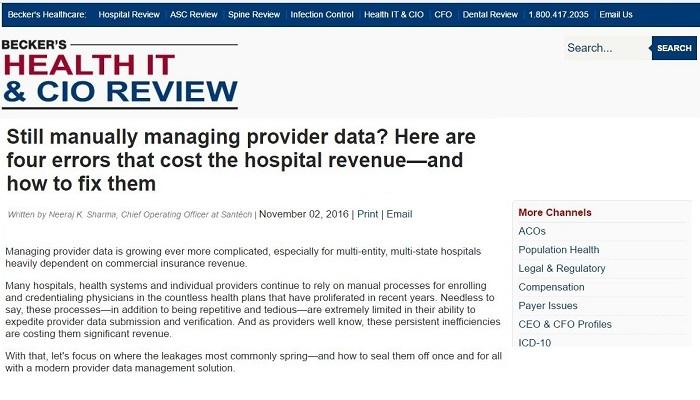
Managing provider data is growing ever more complicated, especially for multi-entity, multi-state hospitals heavily dependent on commercial insurance revenue.
Many hospitals, health systems and individual providers continue to rely on manual processes for enrolling and credentialing physicians in the countless health plans that have proliferated in recent years. Needless to say, these processes—in addition to being repetitive and tedious—are extremely limited in their ability to expedite provider data submission and verification. And as providers well know, these persistent inefficiencies are costing them significant revenue.
With that, lets focus on where the leakages most commonly spring—and how to seal them off once and for all with a modern provider data management solution.
Provider data is stored in disjointed and multiple systems across different departments. This is a recipe for problems such as outdated provider directories, denied claims, patient dissatisfaction and other serious issues that threaten a healthy revenue flow. The solution: house data in a central hub that updates and synchronizes provider data across every department that relies upon it. Such automation is an essential feature of a robust provider data management system, equipping provider organizations with a proverbial single source of truth—at least regarding physician data.
Upon implementation, hospitals and health systems immediately benefit from the elimination of time-consuming repetition. More permanently, denied claims become fewer and farther between. Of course, such a central hub must have the technological capability to easily integrate with other systems, departments and even external data sources.
There is no system of checks and balances to easily review and confirm that provider data is accurate and up-to-date. This one deficiency can seriously delay provider onboarding to new plans, with the domino effect of related delays in reaping revenue. So while a central hub goes a long way in managing, changing and updating data across the healthcare organization, an advanced data management platform should also include features that flag and notify enrollment and credentialing staff when these activities need to be done and for which physicians. Further, these alerts should be proactive, based on state regulations, payer (commercial or government) rules and physician specialty.
Importantly, a provider data management system that keeps these rules continuously updated is a smart and efficient replacement for the old way of entrusting this information to staff within disparate departments.
No ability to simultaneously update provider data across different plans. It is not uncommon to take weeks or longer to enroll providers in a single plan. Most organizations simply arent equipped to handle provider enrollment at scale, or at least to collect, verify and submit provider data across different plans. As such, enrollment applications frequently come back to the provider requesting more information. Inevitably, this sets off a chain of phone tag, emails and other attempts between payer and provider to confirm, send and receive the needed information. No wonder enrollment can stretch out over months! And its a process that providers have to repeat over and over for different payer networks and health plans, for each physician. This may not significantly affect the payer. But it will negatively impact the financial health of the hospital or health system. The key question is: how can this process be accelerated?
The best way is with a provider data management solution that standardizes and auto-populates provider data, such as contact information, specialty, locations, ability to receive new patients and more, across different plan applications. It will essentially perform a paperless review of credentialing verification activities, cutting through repetition with centralized document management, automated electronic signatures, integration with third party provider verification services and more.
As an added bonus, a centralized system for provider data management automatically tracks all activities done for each credentialing and enrollment assignment—valuable proof if needed to challenge a denied claim. This backup exists regardless of staff turnover, with no one person holding this specialized knowledge.
Post-credentialing, provider data integrity lapses. Manual enrollment and credentialing is such a drawn-out process, its no wonder that some hospital departments take a once-and-were-done perspective of these two necessary tasks. Yet this operational philosophy will undoubtedly lead to outdated provider directories, which then results in unhappy patients who wont be back for services, even if they are deemed in-network. In short, completion of credentialing isnt the end of the story. Providers should stay on top of the plans in which they are enrolled so that they dont lose participation without knowing it.
Here again, a centralized, automated, rules-based provider data management system can keep providers current with a practically unlimited number of plans, at a fraction of the time that manual processes used to require. Now staff members can be reassigned to high-touch functions that require more human intervention and follow-up. Indeed, with a modern data management platform facilitating the vast majority of the enrollment and credentialing work, these more layered tasks will now take less time to complete, as well.
There is a lengthy list of challenges to tackle in todays healthcare arena. But with the right provider data management system in place, efficiently enrolling and credentialing providers is no longer one of them.
The views, opinions and positions expressed within these guest posts are those of the author alone and do not represent those of Beckers Hospital ReviewBeckers Healthcare. The accuracy, completeness and validity of any statements made within this article are not guaranteed. We accept no liability for any errors, omissions or representations. The copyright of this content belongs to the author and any liability with regards to infringement of intellectual property rights remains with them.